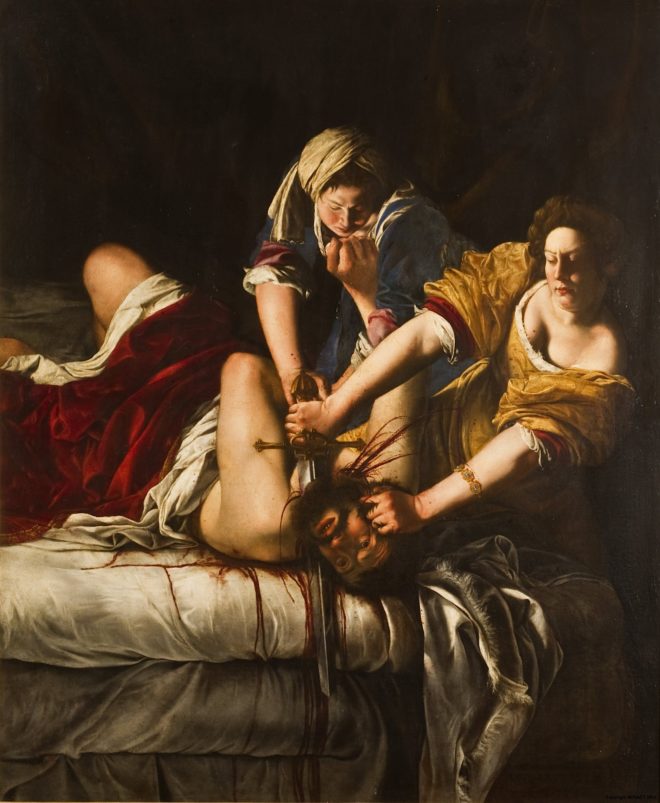À PROPOS DE L'OEUVRE:
Judith DÉCAPITANT Holofernes
1614-1620, 199×162 CM, GALLERIA DEGLI UFFIZI, FLORENCE
« Le Seigneur l’a frappé par la main d’une femme ». C’est ce que dit Judith, une jeune juive de Béthulie, dans la Bible lorsqu’elle décrit son acte héroïque qui a libéré le peuple d’Israël du siège de l’armée de Nabuchodonosor. Judith se rendit au campement du farouche Holopherne, général de l’armée ennemie, vêtue de ses plus beaux atours et feignant de vouloir nouer une alliance. Frappé par sa beauté, le général assyrien l’invite à un somptueux banquet sous sa tente. Après avoir mangé et bu, Holopherne, maintenant ivre, s’endormit sur son lit, permettant à Judith de saisir sa chance de dégainer son cimeterre et de porter le coup mortel.
Dans ce tableau puissant de la Galerie des statues et des peintures des Offices (vers 1620), Artemisia Gentileschi dépeint le moment où Holopherne est tué par la main de Judith, déterminée et puissante. L’effet d’ensemble est à la fois puissant et effrayant : le général ivre et corpulent est allongé sur le lit, la tête saisie par les cheveux et l’épée enfoncée dans le cou. De plus, Artemisia n’a pas hésité à ajouter le détail sanglant du sang giclant si abondamment qu’il tacherait la poitrine de Judith. Le tableau fut achevé à Rome où Artemisia revint après avoir passé sept ans à Florence et où elle put à nouveau apprécier les œuvres du Caravage. La « virilité » naturaliste de l’œuvre provoque de vives réactions à son arrivée à Florence et le tableau se voit refuser l’honneur d’être exposé à la Galerie ; en fait, ce n’est qu’avec de grandes difficultés et avec l’aide de son ami Galileo Galilei que le peintre a réussi à obtenir le paiement, avec un retard important, qui avait été convenu avec le grand-duc Cosme II de Médicis, décédé en 1621 peu après la grande toile était achevée.
Aujourd’hui, ce tableau représente aussi l’histoire humaine et professionnelle d’une femme qui a choisi d’être artiste à une époque dominée par les hommes ; elle y réussit, travaillant dans les cours de Rome, Florence et Naples, voyageant en Angleterre et devenant finalement la première femme à entrer à l’Académie d’art et de design de Florence.
À PROPOS DE L'ARTISTE : ARTEMISIA GENTILESCHI
Artemisia Lomi ou Artemisia Gentileschi (8 juillet 1593 – c. 1656) était un peintre baroque italien. Gentileschi est considéré comme l’un des artistes les plus accomplis du XVIIe siècle, travaillant initialement dans le style du Caravage. Elle produisait un travail professionnel à l’âge de quinze ans. À une époque où les femmes avaient peu d’opportunités de suivre une formation artistique ou de travailler comme artistes professionnelles, Gentileschi a été la première femme à devenir membre de l’Accademia di Arte del Disegno à Florence et elle avait une clientèle internationale.
De nombreuses peintures de Gentileschi présentent des femmes issues de mythes, d’allégories et de la Bible, y compris des victimes, des suicides et des guerriers. Gentileschi était connue pour être capable de représenter la figure féminine avec un grand naturalisme et pour son habileté à manipuler la couleur pour exprimer la dimension et le drame.
Ses réalisations en tant qu’artiste ont longtemps été éclipsées par l’histoire du viol d’Agostino Tassi alors qu’elle était une jeune femme et sa participation au procès de son violeur. Pendant de nombreuses années, Gentileschi a été considérée comme une curiosité, mais sa vie et son art ont été réexaminés par les chercheurs des XXe et XXIe siècles. Elle est maintenant considérée comme l’une des peintres les plus progressistes et les plus expressives de sa génération, avec la reconnaissance de ses talents illustrés par de grandes expositions dans des institutions des beaux-arts de renommée internationale, telles que la National Gallery de Londres.
about the artwork :
Judith Slaying Holofernes
1614–1620, 199×162 CM, GALLERIA DEGLI UFFIZI, FLORENCE
“The Lord has struck him down by the hand of a woman”. So says Judith, a young Jew from Bethulia, in the bible when she describes her heroic act that freed the people of Israel from the siege by Nebuchadnezzar’s army. Judith went to the encampment of the fierce Holofernes, general of the enemy army, dressed in her best clothes and feigning a wish to forge an alliance. Struck by her beauty, the Assyrian general invited her to a lavish banquet in his tent. After eating and drinking, Holofernes, now drunk, fell asleep on his bed, allowing Judith to seize her chance to draw her scimitar and strike the deadly blow.
In this powerful painting in the Gallery of the Statues and Paintings of the Uffizi, (c. 1620), Artemisia Gentileschi portrays the moment that Holofernes is killed by the hand of the determined and powerful Judith. The overall effect is both powerful and frightening: the drunk corpulent general is lying on the bed, his head grasped by his hair and the sword plunged into his neck. Furthermore, Artemisia did not shy away from adding the gory detail of blood spurting so profusely as to stain Judith’s breast. The painting was completed in Rome where Artemisia returned after spending seven years in Florence and where she was able to appreciate Caravaggio’s works once more. The naturalistic “virility” of the work provoked strong reactions on its arrival in Florence and the painting was denied the honor of being exhibited in the Gallery; in fact, it was only with great difficulty and the help of her friend Galileo Galilei that the painter managed to extract the payment, with a significant delay, that had been agreed with Grand Duke Cosimo II de’ Medici, who died in 1621 shortly after the great canvas was completed.
Today, this painting also represents the human and professional tale of a woman who chose to be an artist in an era dominated by men; in this she succeeded, working in the courts of Rome, Florence and Naples, traveling to England and finally becoming the first woman to enter the Academy of Art and Design in Florence.
ABOUT THE ARTIST:
ARTEMISIA GENTILESCHI
Artemisia Lomi or Artemisia Gentileschi (8 July 1593 – c. 1656) was an Italian Baroque painter. Gentileschi is considered among the most accomplished seventeenth-century artists, initially working in the style of Caravaggio. She was producing professional work by the age of fifteen. In an era when women had few opportunities to pursue artistic training or work as professional artists, Gentileschi was the first woman to become a member of the Accademia di Arte del Disegno in Florence and she had an international clientele.
Many of Gentileschi’s paintings feature women from myths, allegories, and the Bible, including victims, suicides, and warriors. Gentileschi was known for being able to depict the female figure with great naturalism and for her skill in handling colour to express dimension and drama.
Her achievements as an artist were long overshadowed by the story of Agostino Tassi raping her when she was a young woman and her participation in the trial of her rapist. For many years Gentileschi was regarded as a curiosity, but her life and art have been reexamined by scholars in the twentieth and twenty-first centuries. She is now regarded as one of the most progressive and expressive painters of her generation, with the recognition of her talents exemplified by major exhibitions at internationally esteemed fine art institutions, such as the National Gallery in London.

